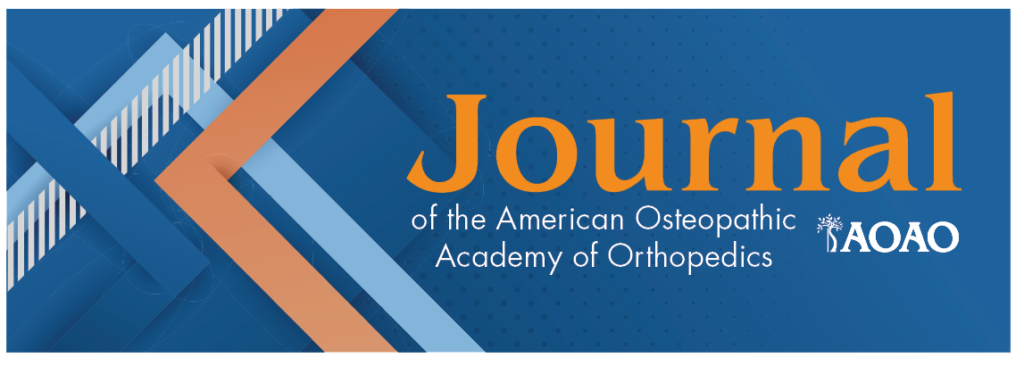Morgan Turnow DO1; Minali Nemani BS2; Desiree Ojo DO3; Sarah Willard MS4; Grace Thiel BS5; Elizabeth Chan BS6; Arianna Gianakos DO7
1OhioHealth Doctors Hospital Department of Orthopedic Surgery, 5100 W. Broad Street, Columbus, OH
2Edward Via College of Osteopathic Medicine, 4408 Bon Aire Dr, Monroe, LA 71203
3Inspira Medical Center Department of Orthopaedic Surgery, 1505 West Sherman Avenue, Vineland, NJ 08360
4Lake Erie College of Osteopathic Medicine, 20 Seton Hill Dr, Greensburg, PA 15601
5Kansas City University, 1750 Independence Ave, Kansas City, MO 64106
6Campbell University of Osteopathic Medicine, 4350 US Hwy 421 S, Lillington, NC 27546
7Department of Orthopedic Surgery, Yale Medicine, Orthopaedics and Rehabilitation, 800 Howard Avenue, Fl 1st, New Haven CT 065519
DOI: 10.70709/cxvvfo1qkp
Abstract
Background
Matching into competitive surgical specialties, including orthopedic surgery, has been a competitive task for medical students; however, Doctors of Osteopathic Medicine (DO) and females are some of the least represented groups in orthopedic surgery residency programs. While females represented nearly 50% of United States medical residents in 2023, they only represented 20.14% of orthopedic surgery residents. Female DO residents comprised less than 2% of orthopedic surgery residents in 2023. As interest in orthopedics rises for all medical students, it is crucial to look at the trends of how underrepresented groups are represented within the field of orthopedic surgery.
Objective
To determine how female DO graduates fare in the orthopedic surgery residency program selection process from 2020-2023 and to forecast data through 2033.
Methods
This is an analysis of publicly available data from the National Residency Match Program. Data from the National Residency Match Program was collected from 2020-2023 and included the total number of DO and MD orthopedic surgery applicants, the total number of female applicants, and the number of matched female DO and MD applicants. Additionally, the number of incoming female DO orthopedic surgery residents for the next ten years (2024-2033) was forecasted using a linear regression model, along with their corresponding confidence intervals.
Results
From 2020 to 2023, female orthopedic surgery residents increased in number (2020-2021: +58; 2021-2022: +61; 2022-2023: +86). Of DO orthopedic residents from 2020 to 2023, there was a steady rise in female DO residents. Female DO residents made up 10.17% of DO orthopedic residents in 2020, 11.09% in 2021, 10.80% in 2022, and 13.21% in 2023. Female DO residents saw a 50.94% increase while MD female residents saw a 28.66% increase from 2020 to 2023. Based on the most recent data from 2020-2023, we are expecting to see 160.71 ± 6.44 female osteopathic orthopedic surgery residents in 2033. The predicted annual percent change between 2023 and 2033 is between + 5% to 10%. Over the 10 years, that would be interpreted to be 8.29 more female DO residents annually.
Conclusion
Our study demonstrated that female osteopathic students comprise less than 2% of all orthopedic surgery residents. While the total composition of U.S. orthopedic surgery residents has shown an upward trend in female trainees, this value has only risen by 1.54% over four years. We hope that this research study increases awareness of the lack of DO female representation within the field of orthopedic surgery.
Keywords: Orthopedics, female, osteopathic, match, residency
Introduction
Medical schools and residency programs have made strategic efforts to achieve gender parity in medicine. (1-3) These efforts have paid dividends, as female medical students now make up over half of all medical students in the United States (US). (3) However, gender parity has not been achieved in many of the surgical specialties among residents. While it is noteworthy to recognize the remarkable strides that have been made to reach a 48.3% female prevalence in all US residency programs in 2023; gender equality within surgical specialties has lagged, particularly in orthopedic surgery. (3) In a 2023 report, only 20.14% of orthopedic surgery residents were female. (3, 4) This disparity is less apparent in other competitive surgical specialties such as ophthalmology, urology, and general surgery.
Prior studies have demonstrated that a more diverse, gender-balanced physician workforce can improve patient care and overall patient satisfaction. (3) Despite these benefits, women remain underrepresented in orthopedic surgery. Notably, female applicants have a match rate reflective of their male peers; however, there are significantly fewer females applying to orthopedic surgery. (3) Female orthopedic surgeons in practice had a growth rate of approximately 2% per year between 2010 and 2019. This growth trajectory is projected to take approximately 217 years for orthopedic surgery to reach gender paucity. (4, 5)
The disparity in orthopedic surgery residency programs can be further stratified for Doctors of Osteopathic Medicine (DO). There were approximately 21,000 Doctor of Medicine (MD) graduates and 8,000 DO graduates in 2023. DO students, especially females, are extensively underrepresented in surgical specialties and to a greater degree in the field of orthopedics, comprising less than 2% of all orthopedic surgery residents as of 2023. Overall, DO candidates have yet to match into orthopedic surgery at the same rate as their allopathic (MD) counterparts. (6) This study aims to evaluate the trends of female DO orthopedic residents within the US. With the growing number of female medical students, we anticipate that women will continue to be increasingly represented in the field of orthopedics.
Methods
This is a respective analysis of publicly available data from the National Residency Match Program (NRMP) Main Residency Match Data ((Main page: https://www.nrmp.ortho/match-data-analytics/resdiency-data-reports/). Data was collected from 2020-2023 and included the total number of DO and MD orthopedic surgery applicants, the total number of female DO and MD applicants, and the number of matched female DO and MD applicants. Descriptive statistics were used to illustrate the data as total numbers and percentages. Analysis was performed using Microsoft Excel and evaluated with a one-tailed two-proportion z test for statistical significance set to a p value less than 0.05 (Redmond, WA). The number of incoming female DO orthopedic surgery residents for the next ten years (2024-2033) was forecasted using a linear regression model in Microsoft Excel version 16.78. This forecasting function in Excel utilizes data from previous years (2020-2023) to create a precise model predicting future values (2024-2033) along with their corresponding confidence intervals. (7-9)
Results
There were fewer than 100 female DOs in the 4200+ orthopedic residents in any given academic year between 2020-2023. From 2020 to 2021 and 2022 to 2023, there was an increase in the number of female DO residents in orthopedic surgery. From 2021 to 2022 the number of female DO residents in orthopedic surgery remained stagnant (Table 1). The percentage of female DO residents increased in 2021 and 2023 by 18.25% and 24.32%, respectively. Between 2020-2023, the year-to-year change in female DO residents was not a statistically significant increase. In 2020 the percentage of orthopedic residents who were female DOs was 1.26%, and by 2023 that percentage was 1.84%. The increase in the number of female DO orthopedic surgery residents from 2020 to 2023 was statistically significant (p < 0.05).
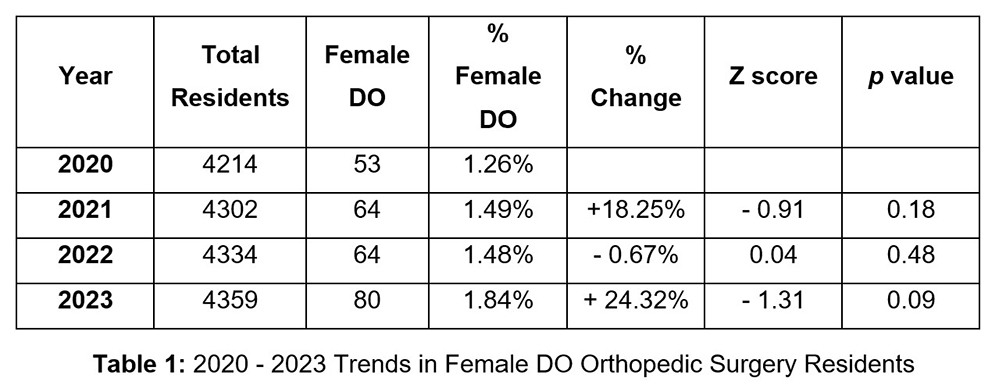
Female residents comprised 15.97% of orthopedic surgery residents in 2020 and made up 20.14% in 2023. From 2020 to 2023, the number of female orthopedic surgery residents increased each year (2020-2021: +58; 2021-2022: +61; 2022-2023: +86). The largest increase in female orthopedic surgery residents occurred from 2022 to 2023. Female DO orthopedic residents increased from 2020-2023. Female DO residents are slowly rising in representation amongst female orthopedic surgery residents over time, making up 7.88% of female orthopedic residents in 2020 and 9.11% of female residents in 2023. While from 2021 to 2022 the number of female DO orthopedic surgery residents remained stagnant at 64 residents, the female total and female non-DO orthopedic residents continued to rise (Figure 1).
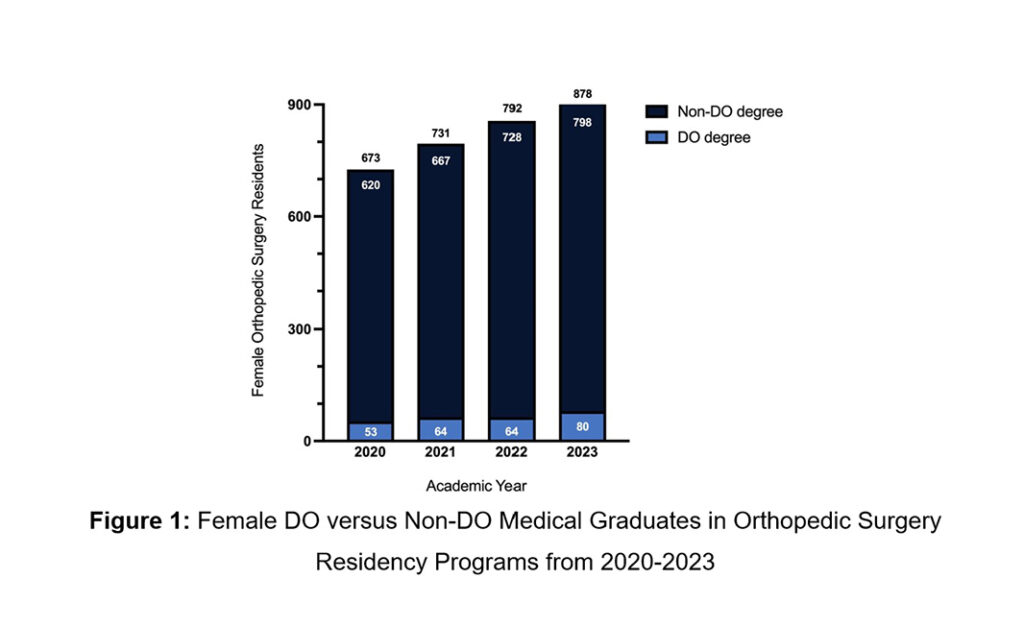
While the total makeup of orthopedic surgery residents in the U.S. has increasingly had more DO residents from 2020 to 2023, this value has only marginally increased over four years (Figure 2). Orthopedic surgery residents consisted of 12.39% DO in 2020 to 13.93% DO in 2023. Female DO residents increased by 0.58% while male DO residents increased by 0.96% from 2020 to 2023. Of the osteopathic medical graduate orthopedic residents from 2020 to 2023, there was a steady rise in female DO residents. Female DO residents made up 10.17% of DO orthopedic residents in 2020, 11.09% in 2021, 10.80% in 2022, and 13.21% in 2023. Male DO residents experienced a drop in 2023 from 12.23% to 12.09% of orthopedic surgery residents, while female DO residents experienced a rise from 1.48% to 1.84%.
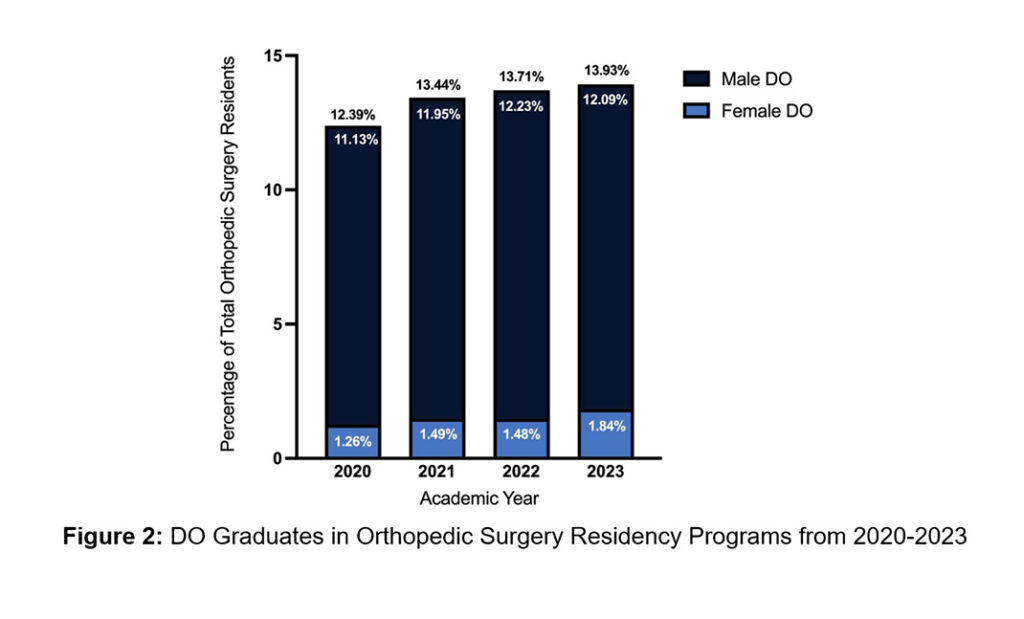
Based on the most recent female DO data from 2020-2023, we are expecting to see 160.71 ± 6.44 female osteopathic orthopedic surgery residents in 2033 (Figure 3). Over the 10 years, that would translate to 8.29 more female DO residents annually. By 2033, female DOs would make up 3.33% of orthopedic surgery residents. Compared to 2020, female DO orthopedic surgery residents will triple by 2033 to 160.71 residents. With a confidence interval spanning over 12.87 residents, the annual increase could be as little as 1-2 female DO residents (Table 1).
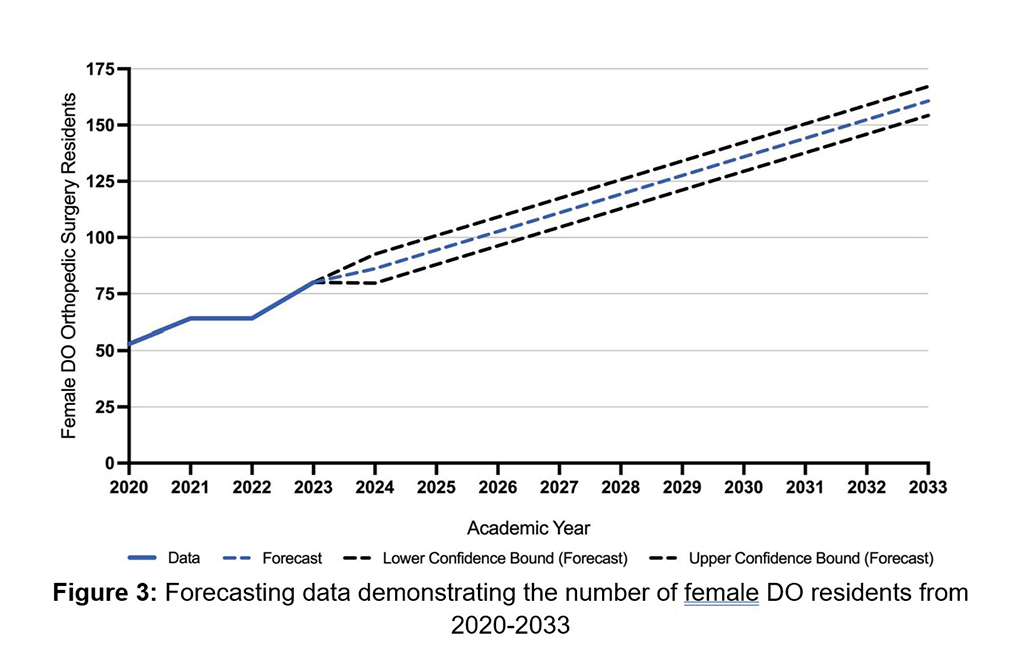
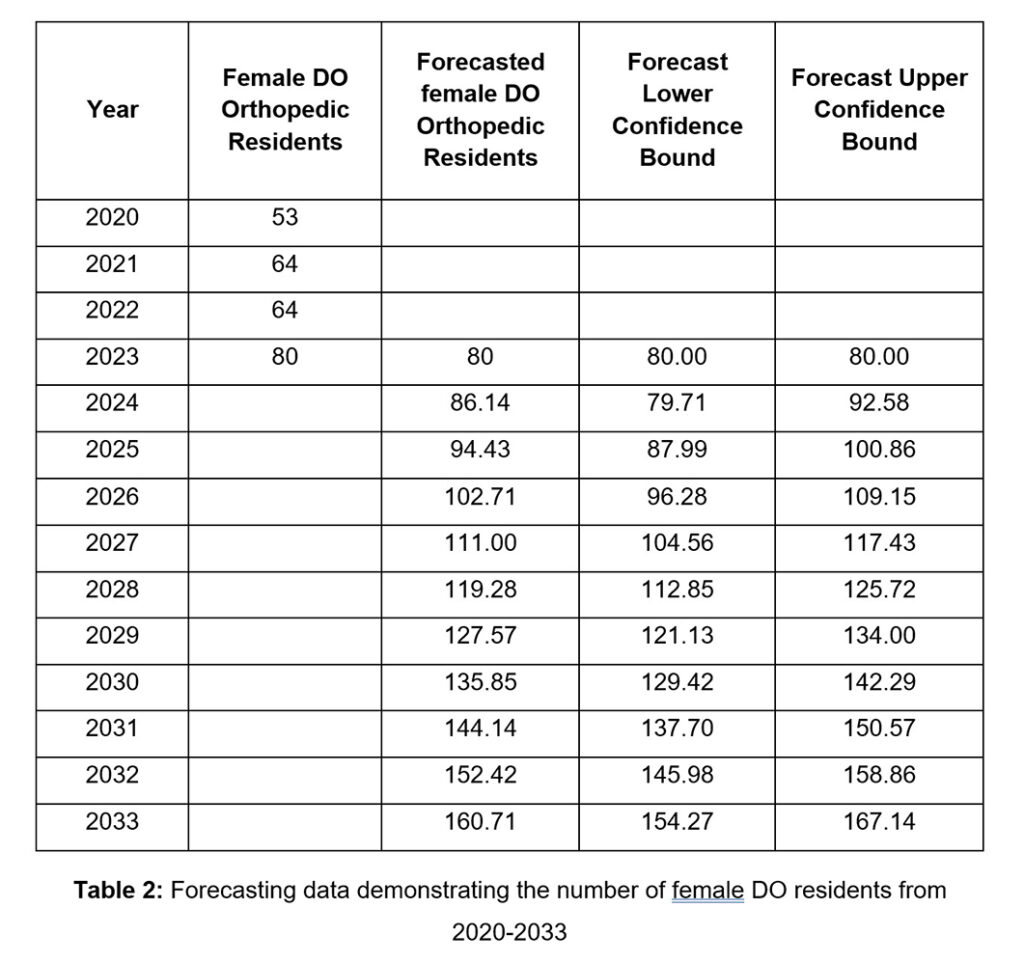
The predicted annual percent change in female DO orthopedic residents between 2024 and 2033 is between + 5% to 10% (Figure 4). The annual percent change peaks at + 8.50% in 2025 and steadily declines over the next eight years. From 2025 to 2026, the percent change in female DO residents decreases by 0.84%. Subsequently, from 2032 to 2033 there is a percent change decrease by 0.29% and therefore approaching a steady percent change value by 2033 of + 4.44%.

Discussion
This study aimed to investigate recent trends in female DO orthopedic surgery residents over the past four application cycles and provide predictions through 2033. The main findings reveal a minimal percent increase in the number of female DO orthopedic surgery residents, increasing from 1.26% to 1.84% from 2020 to 2023, respectively. Although the number of DO orthopedic surgery residents has increased for both males and females, female DOs are significantly less represented in orthopedic surgery than their male DO and allopathic counterparts. Considering percentile changes is important and the focus of this study, as the annual graduation numbers between allopathic and osteopathic medical schools vary greatly. In 2023, allopathic schools had 20,920 graduates, while osteopathic schools only accounted for 7,891 graduates. (10, 11) Percentile comparison, therefore, provides better insight compared to raw data. Forecasting through 2033 suggests the percent change from 2024 to 2033 is marginal. This trajectory raises concern and emphasizes a priority to investigate the etiology of this phenomenon.
In 2021, the American Osteopathic Association (AOA) and the Accreditation Council for Graduate Medical Education (ACGME) merged into a single accreditation system (SAS). (12) Prior to the merger, DO applicants were restricted to AOA residency programs and a limited few ACGME programs. (13) While this merger was anticipated to provide a unified match that would lead to a greater percentage of opportunities for allopathic and osteopathic students alike, surgical subspecialties have yet to demonstrate this perceived benefit. In fact, since 2021, there has been less DO representation in post-graduate year one (PGY-1) surgical specialty positions when compared to positions held antecedent to the SAS. (13) DO medical students no longer have protected residency spots that were previously available in the AOA match. MD and international medical graduate (IMG) applicants are now able to apply to these previously protected program spots, which potentially contributes to the downward trend in DO match rates each year. (6) The data included in our study encompasses the match climate immediately after the implementation of the SAS and demonstrates the potentially detrimental impact that DO medical students experience in the post-merger surgery match. Osteopathic medical students and osteopathic physicians have long fought bias and discrimination in comparison to their allopathic counterparts. In fact, 63% of program directors report they would seldom or never interview a DO applicant. (14)
While osteopathic medical students have been having trouble matching into orthopedic surgery residency programs even after the implementation of the SAS, they make up an increasing percentage of orthopedic surgery residents each year. DOs made up 13.27% of ACGME orthopedic surgery PGY-1 positions in 2020, 12.36% in 2021, 12.69% in 2022, 13.24% in 2023, and 45.70% in 2024. (15) The DO match rates, however, have been decreasing from 63.28% in 2020, 61.85% in 2021, 54.15% in 2022, and 50.21% in 2023. (16) The most recent match data from 2024 recorded the lowest DO match rate to date, demonstrating a 45.70% match rate. DO medical student applicants are not considered at every residency program as over 20% of residency programs report not interviewing or ranking DO applicants. (14) Additional factors including signaling preferences were recently incorporated in 2022 by the AAMC. (16) The goal of this program was to have applicants “signal” programs to indicate their interest and potentially increase their chances at receiving an interview. Recently, the standardized USMLE Step 1 and COMLEX Level 1 examinations transitioned to a pass / fail format rather than a three-digit score. Without a three-digit score, it is believed that other factors, including research, will be a large focus. (17) Additional barriers to DO females in orthopedic surgery are listed below in Table 3. A majority of DO medical schools are not affiliated with a home orthopedic surgery residency program, making it difficult to get involved with research as a student. Only 12% of osteopathic medical school’s report receiving outside funding to conduct research, and nearly 80% of DO students describe difficulties in getting involved with research. (18)
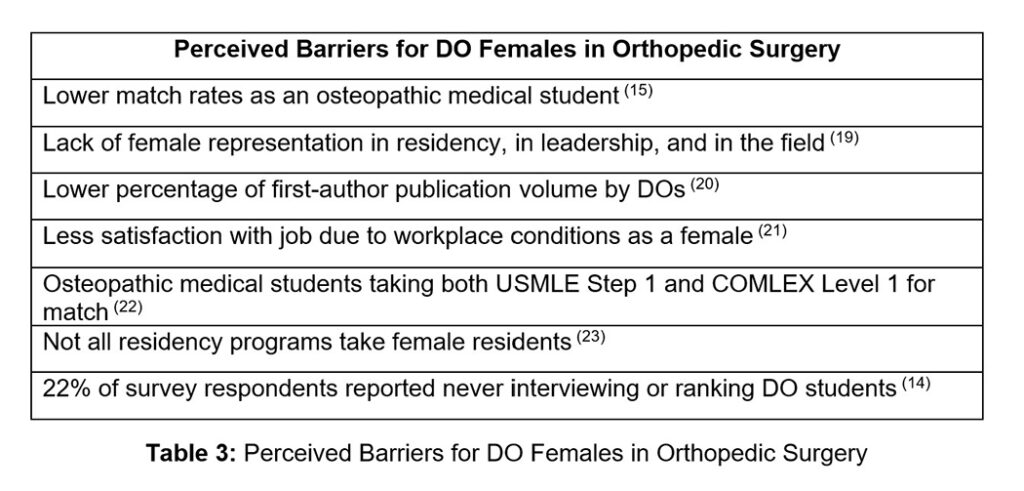
The Student American Osteopathic Academy of Orthopedics (SAOAO) is an organization that specifically supports osteopathic students who aspire to be orthopedic surgeons and serves as a resource for students to network, collaborate, and learn. (24) This includes student membership in local chapters at 42 osteopathic schools and the opportunity to attend spring and fall national-level SAOAO conferences. SAOAO also includes member-only access to grants, scholarships, and other resources (24) REAM Ortho (Research Education and Mentorship in Orthopedics) is a predominately osteopathic medical student and resident-led national interest group that seeks to end the overt disparity in research opportunities experienced during osteopathic training. This organization also provides students with personalized advising and mentorship throughout the research process to further support the evolving future of orthopedic surgery. (25) Both programs provide osteopathic medical students with scholarly opportunities that further support exceptional candidates as particularly distinctive in their application to residency programs.
Despite the pervasive underrepresentation of females in orthopedics, several organizations are working to close the gender gap. Inclusive organizations such as the Perry Initiative, the Ruth Jackson Orthopaedic Society, and Nth Dimensions continue to provide opportunities to inspire women to consider orthopedic surgery as a specialty choice. (26) See Table 4 for a list of organizations / resources available to support women in orthopedics (Table 4). The Perry Initiative supports future health practitioners by providing mentorship and free surgery workshops with power tools to students from high school through medical school. (27) The RJOS promotes the professional development of women in orthopedics throughout all stages of their careers by providing mentorship, leadership opportunities, and learning summits. This includes member-only access to grants, scholarships, and other resources. (26) Nth Dimensions is an organization that expands inclusive opportunities to female medical students and underrepresented minorities. (28) This program includes free hands-on workshops as well as a summer internship for rising second-year medical students. (28) Nth Dimensions screens medical student applications to ensure equality in their meeting attendance. Furthermore, RJOS and Nth Dimensions host annual meetings and symposiums to further develop and enrich a welcoming orthopedic landscape for female applicants. These programs utilize skill-building and networking to propel the success of aspiring female orthopedic surgeons. It is important to note, however, that these programs are open to all female medical students, residents, and attendings, and are not specific to MD or DO. Further, these programs have very few DO women in their leadership positions.
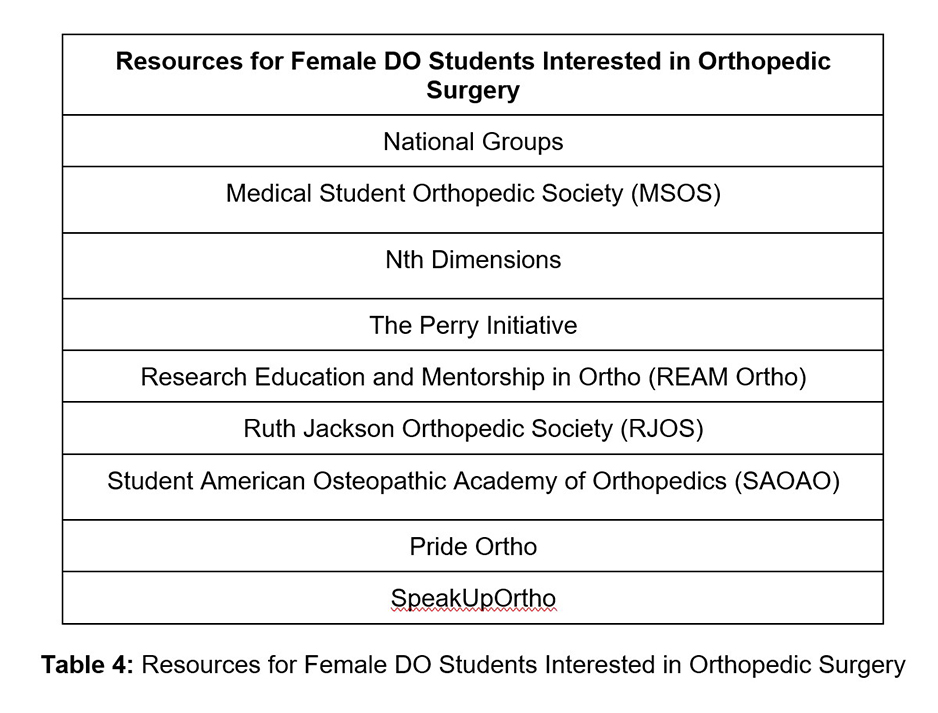
Conclusion
Our study demonstrated that female osteopathic students comprise less than 2% of all orthopedic surgery residents. We identified a minimal percent increase of female DO orthopedic surgery residents from 1.26% to 1.84% from 2020 to 2023. While the total composition of U.S. orthopedic surgery residents has shown an upward trend in female trainees, this value has only risen by 1.54% over the course of four years. Orthopedic surgery organizations such as Perry Initiative, RJOS, Nth Dimensions, SAOAO, and REAM Ortho provide resources, skills workshops, research projects, and conferences to provide opportunities for women in the pursuit of a career in orthopedic surgery. These programs encourage women to pursue careers in orthopedics by providing mentorship and kinesthetic workshops that will pique surgical interest and hone tactile skills early in their careers. However, even these programs lack DO representation. With the growing number of female orthopedic surgery residents, we anticipate that women will continue to be increasingly represented in the field of orthopedics.
References
- Harris AB, Vankara A, McDaniel C, Badin D, Laporte D, Aiyer A. Match Rates Among Underrepresented Minority and Female Applicants to Orthopaedic Surgery Residency Programs from 2011 to 2021: How Are We Doing?. JB JS Open Access. 2023;8(3):e23.00049. Published 2023 Aug 18. doi:10.2106/JBJS.OA.23.00049
- The Association of American Medical Colleges. Report on Residents: 2022-23 Active Residents; 2023. Available at: https://www.aamc.org/data-reports/students-residents/data/report-residents/2023/table-b3-number-active-residents-type-medical-school-gme-specialty-a
- Pinpin C, White PB, Nellans KW, Bitterman AD, Mulcahey MK, Cohn RM. Exponential Growth in Female Residency Applicants in Orthopaedic Surgery Over the Past 15 Years. JB JS Open Access. 2023;8(2):e23.00004. Published 2023 May 30. doi:10.2106/JBJS.OA.23.00004
- Female Persons, Percentage. United States Census QuickFacts. Accessed May 7, 2024. https://www.census.gov/quickfacts/fact/table/US/SEX255222.
- Acuña AJ, Sato EH, Jella TK, Samuel LT, Jeong SH, Chen AF, Kamath AF. How long will it take to reach gender parity in orthopaedic surgery in the United States? An analysis of the National Provider Identifier Registry. Clin Orthop Relat Res. 2021; 479(6):1179-89.
- Modica A, Ranson R, Williamson T, Ponce BA, Cohn RM, Bitterman AD. Osteopathic Students Have Decreased Match Rates in Orthopaedic Surgery Compared with Allopathic Students. JB JS Open Access. 2024;9(2):e24.00027. Published 2024 Jun 4. doi:10.2106/JBJS.OA.24.00027
- Nadler, S. & Kros, John. (2007). Forecasting with Excel: Suggestions for Managers. Spreadsheets in Education (eJSiE). 2.
- W. A. Stout and B. Tawney, “An Excel forecasting model to aid in decision making that affects hospital resource/bed utilization – hospital capability to admit emergency room patients,” 2005 IEEE Design Symposium, Systems and Information Engineering, Charlottesville, VA, USA, 2005, pp. 222-228, doi: 10.1109/SIEDS.2005.193261.
- Hussein T, Hammad MH, Fung PL, Al-Kloub M, Odeh I, Zaidan MA, Wraith D. COVID-19 Pandemic Development in Jordan-Short-Term and Long-Term Forecasting. Vaccines (Basel). 2021 Jul 2;9(7):728. doi: 10.3390/vaccines9070728. PMID: 34358145; PMCID: PMC8310337.
- “Total Graduates by U.S. MD.” Accessed June 21, 2024. https://www.aamc.org/media/6111/download?attachment
- Graduates by Gender. Accessed June 21, 2024. https://www.aacom.org/searches/reports
- ACGME. Transition to a single GME accreditation system history.Accreditation Council for Graduate Medical Education. https://www.acgme.org/about-us/transition-to-a-single-gme-accreditation-system-history/ [Accessed 21 May 2024]
- Williamson TK, Martinez VH, Ojo DE, Allen CB, Fernandez R, Larson J, Timoney M, Sees JP. An analysis of osteopathic medical students applying to surgical residencies following transition to a single graduate medical education accreditation system. J Osteopath Med. 2023 Nov 3;124(2):51-59. doi: 10.1515/jom-2023-0118. PMID: 37921195.
- NRMP. Results of the 2022 NRMP program directors’ survey. chrome-extension://efaidnbmnnnibpcajpcglclefindmkaj/https://www.nrmp.org/wp-content/uploads/2022/09/PD-Survey-Report-2022_FINALrev.pdf [Accessed 14 Jul 2023].
- Brazdzionis J, Savla P, Oppenheim R, et al. Comparison of Osteopathic (DO) and Allopathic (MD) Candidates Matching Into Selected Surgical Subspecialties. Cureus. 2023;15(6):e40566. Published 2023 Jun 17. doi:10.7759/cureus.40566
- Sorenson JC, Ryan PM, Ward RA, Fornfeist DS. The Value of Signaling an Orthopaedic Surgery Program: A Survey to Orthopaedic Surgery Programs. J Am Acad Orthop Surg Glob Res Rev. 2023;7(6):e23.00050. Published 2023 Jun 2. doi:10.5435/JAAOSGlobal-D-23-00050
- Gu A, Farrar J, Fassihi SC, et al. Effect of Change in USMLE Step 1 Grading on Orthopaedic Surgery Applicants: A Survey of Orthopaedic Surgery Residency Program Directors. J Am Acad Orthop Surg Glob Res Rev. 2021;5(5):e20.00216. Published 2021 May 4. doi:10.5435/JAAOSGlobal-D-20-00216
- Ho A, Auerbach A, Faulkner JJ, Guru SK, Lee A, Manna D. Barriers to research opportunities among osteopathic medical students. J Osteopath Med. 2023;123(4):187-194. Published 2023 Feb 1. doi:10.1515/jom-2022-0116
- Fram, Brianna, Jillian Kazley, and Lisa Cannada. 2023. “Orthopedic Sub-Specialties Vary in Representation of Female Fellowship Program Directors.” Journal of Orthopaedic Experience & Innovation 4 (2). https://doi.org/10.60118/001c.75452.
- Albana MF, Bianco LD, Walsh JW, Henken-Siefken A, Wu ES. Trends in osteopathic authorship in Orthopedic Publications and its impact on adult reconstruction match rates. Arthroplasty Today. 2023;24:101276. doi:10.1016/j.artd.2023.101276
- Rodarte, Patricia, Maria S. Kammire, Lisa K. Cannada, Selina Poon, and Heidi Israel. 2022. “The ‘Other Side’ of Conflict: Examining the Challenges of Female Orthopaedic Surgeons in the Workplace.” Journal of Orthopaedic Experience & Innovation 3 (2). https://doi.org/10.60118/001c.36644.
- Ng J, Johnson R, Saeed A, et al. Trends in Orthopaedic Match Characteristics in an Osteopathic Resident Profile 2.0 . Journal of the American Osteopathic Academy of Orthopedics. 2024;VII(1).
- Van Heest A. Gender Diversity in Orthopedic Surgery: We All Know It’s Lacking, but Why?. Iowa Orthop J. 2020;40(1):1-4.
- AOAO Students. Accessed May 21, 2024. https://students.aoao.org/.
- ReamOrtho. Accessed May 21, 2024. https://www.reamortho.com/.
- Ruth Jackson orthopaedic society (RJOS). Ruth Jackson Orthopaedic Society (RJOS). Accessed May 21, 2024. https://www.rjos.org/.
- Perry Initiative. Accessed May 21, 2024. https://perryinitiative.org/.
- Nth Dimensions. Accessed May 21, 2024. https://www.nthdimensions.org/.
